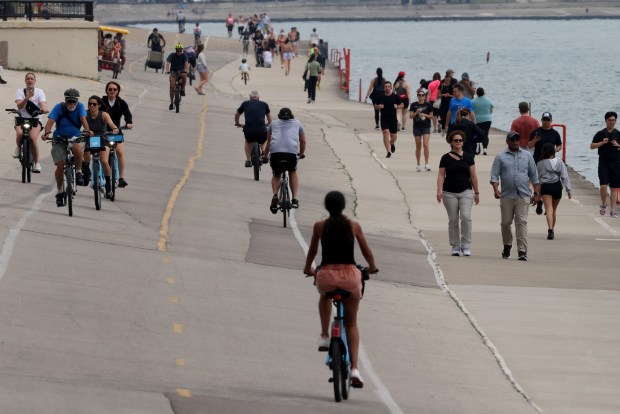Editor’s note: We asked readers to tell us what it’s like to be a cyclist on city streets and to share their thoughts about Chicago’s bike infrastructure. Here are more selections. View more cycling-focused letters here and here.
Chicago’s streets are at a crossroads, and the path we choose will determine the safety and vitality of our city for generations to come. We’ve seen how thoughtfully designed bicycle infrastructure can transform neighborhoods, connecting communities and breathing new life into our urban landscape. We’ve seen a growing number of protected bike lanes, and we’ve seen many of them given concrete protection. The Chicago Department of Transportation’s community-driven approach to expanding the city’s bike network has brought new bike infrastructure to neighborhoods that historically have had few bike lanes, such as Belmont Cragin, Hermosa, Austin, North Lawndale and South Lawndale.
Despite pockets of progress, our city’s overall efforts to create safe, accessible cycling networks are falling dangerously short. The harsh reality is that this piecemeal approach to bicycle infrastructure is costing lives.
Bike infrastructure is only effective when it truly delivers on its promise of safety. The reality in Chicago is far from ideal. Too often, drivers illegally park or stop in bike lanes, forcing cyclists to suddenly swerve into traffic — a potentially life-threatening maneuver. Fortunately, there’s hope on the horizon. The city’s forthcoming Smart Streets program will crack down on these violations, using technology to enforce parking rules in bike lanes, bus lanes and no-parking zones.
In addition to creating safe and effective infrastructure for biking, we must also reduce Chicago’s default speed limit. When drivers kill or injure people biking or walking, it’s often the result of a driver going too fast. With higher speeds, the likelihood of collisions involving severe injuries or fatalities skyrockets. Because of the role speed plays in crashes, lowering the speed limit even a small amount can have an outsize effect on road safety.
We envision a Chicago where every neighborhood is connected by a network of protected bike lanes, where families can safely pedal to schools and parks, and where commuters can choose two wheels over four without fear. This isn’t just a dream — it’s a necessity for a modern, sustainable city.
The benefits of a robust cycling network extend far beyond safety. More people biking means less traffic congestion, better air quality and healthier residents. Not only does it expand affordable transportation options, but it also serves as an investment in our well-being and our city’s future.
We need bold action to transform Chicago into the world-class cycling city it has the potential to be. Lives depend on it, our environment demands it and our future generations deserve it.
— Alex Perez, advocacy manager, Active Transportation Alliance, Chicago
Making lakefront path safer
I am an avid bicycle rider who lives in Edgewater and rides Chicago’s lakefront path several times a week. Although it is one of the most beautiful bike paths in the world, at times, it can be crowded and somewhat dangerous Since the path was redone several years ago, in effect separating walkers/runners from bikers, it has lessened the opportunity for accidents to happen, except on the path between Montrose and Foster avenues.
The bike path heads east, intersecting the soccer fields and the lakefront, where pedestrians cross or walk on the bike path with bikes flying by. The walking path runs adjacent to DuSable Lake Shore Drive away from the lakefront.
I suggest that the bike path and walking path between Montrose and Foster be swapped — an easy fix that would alleviate some of the possible danger zones on the path, making it safer for all.
— Patrick Brennan, Chicago
Drivers, try the Dutch Reach
Two months ago, I would have written a letter extolling the virtues of cycling in Chicago — ease of movement in congested traffic, environmental benefits, personal health, etc. — but that was before someone opened a car door into the bike lane on Elston Avenue just as I was passing. I ended up at immediate care with a bone chip in my left thumb (I am left-handed) and a large hematoma on my right hand, as well as various bruises and aches and pains that have not completely disappeared. I have not been on a bike since and am very nervous at the prospect. I am in my mid-60s and do not bounce back the way I used to.
Since biking is becoming more prevalent in Chicago, I believe it would be in everyone’s best interests for all drivers to follow the Dutch method of opening car doors, known as the Dutch Reach: Use your far hand to reach for the door handle, watch for cyclists and pedestrians, open your door very slowly and get out of the way of traffic as soon as possible. This would prevent so many accidents and possible deaths.
I know that I am lucky to have escaped with only minor injuries, but my life has changed since the accident. I have had two X-rays and thankfully do not need surgery, but am still in a cast and waiting for a third X-ray in four weeks.
For cyclists, I have the following request: Please let people who are walking on the bike paths know when you are going to pass them. I enjoy walking on the bike paths, and I cannot count the number of times I have been surprised by a bike speeding past. I am sure it is just a question of time before someone gets seriously hurt. It’s so easy to shout “On your left” or ring your bell. Also, walkers/joggers who use earbuds, please keep to the side so that you can be passed safely.
— Jaikie Ceisel, Chicago
Slow down on Lakefront Trail
I am a rider on the Lakefront Trail, as well as the streets to get there. The city of Chicago has done a commendable job of making cycling much easier by adding designated bike routes. The generosity of Ken Griffin has made the Lakefront Trail 100% safer.
A couple of my pet peeves are the cyclists themselves — especially the people who want to treat the Lakefront Trail as their personal Tour de France. Slow down! You can’t be riding in excess of 20 mph through the Oak Street Beach bottleneck.
Another issue is that cyclists have to realize that they are held to the same traffic laws as cars. When you come to a traffic light, obey that light. Same goes for a stop sign. At least make an attempt to slow down.
As far as licensing bicycles, I am completely against it. And let’s be realistic: Who is going to enforce it? Our police are already saddled with the weight of world.
— Ed Grunauer, Chicago
The religiosity of city cyclists
I am pro-car cyclist. You read that right. It’s not an oxymoron.
Except in the dead of winter, I ride a bike most days of the year. I am a frequent Divvy rider, often using it to ride home from work. I hop on my bike for errands and leisure. I love the freedom of my bike, as our family of five — all cyclists — has gotten by with just one car for more than 20 years.
When friends ask me why I ride, I respond: “It’s free. It’s good for me. Good for the environment. And it’s the fastest way to get around the city.”
Because I am a realist with perspective, I am simultaneously pro-car. Those stances are not mutually exclusive. I think bikers whine too much.
The number of people who transport themselves by cars dwarfs bike riders. For cyclists to think the world should revolve around us is like vegans who think all food should revolve around them. Please. Get a grip. And some perspective.
Roads were designed for cars, not bikes. The fantasyland many bike zealots live in fancies a carless world. That’s not gonna happen.
Also, if you’ve been cycling as long as I have (I am 55), you pinch yourself at how far bike access has come. We have lanes and signals just for us. That was a pipe dream when I was a kid.
For too many cyclists, these issues take on almost a religious feel. That’s wrong too.
As a biker, I think we have all we need. Is it perfect? Of course not, but neither is owning a car.
— William Choslovsky, Chicago
Animus directed at cyclists
As a 69-year-old resident of Chicago and regular bicyclist who doesn’t own a car, I have been astounded at the amount of animus directed toward me for no apparent reason. I had one driver tell me, “You don’t belong out here,” when I told him he should use the curb lane to make a right turn instead of blocking two lanes and backing up traffic. “King car” people have it all and don’t want anyone to inconvenience them, I guess.
But why do so many drivers encourage cyclists to run through stop signs when it is their turn to go? Other drivers will say, “Cyclists don’t stop at stop signs.” So what to do? I wait until that driver finally gets it. Sometimes, it takes a while and a shout to the driver to “take your turn.”
So when someone calls a protected bike lane “privileged,” I have to vomit because all the privilege lies with the “king cars.” Come on, man! The protected lanes are an improvement, but I have had drivers make right turns across the bike lane, forcing me to turn quickly to avoid being hit.
We are certainly not Europe with respect to bicycles. Why are Americans so perverse when it comes to the safety of others?
And whatever happened to Chicago (Midwest) nice? Joe Williams sang about a city where “people are friendly. Without no hidden plan. It’s the best in the Midwest. It’s a real darn city full of good folks who come from home, and when I get back, I’ll never roam far from my little Chitown.”
Bicyclists pay taxes and do not damage the roads to the extent cars, SUVs and trucks do. Bicyclists are extremely vulnerable on city streets. Many people drive large heavy vehicles to protect them and their families.
How many deaths have bicyclists caused?
I think in the end, the animus is driven by envy. Drivers stuck in traffic see a bicycle go by unimpeded and don’t like it, simple as that. If I’m wrong, somebody explain it to me.
— J. Daniel Humphrey, Chicago
Cyclists need wider shoulders
I am a 69-year-old avid road cyclist living in Lake County. I ride three to five days a week mostly in northern Cook County and Lake County.
We Lake County cyclists do not have the same traffic issues as those in the city of Chicago, as we do not see as many parallel parked cars, so we do not have as many driver door openings. However, we do have a major issue when we need to ride on east-west main streets east of Milwaukee Avenue. State routes such as 132, 120 and 137 and Deerfield Road do not have a good wide riding shoulder. If you take side roads, they intersect with the forest preserve. There is a bicycle path on Illinois Route 176, but that is not always an option. It is a nice safe path, but it is sometimes out of the way.
Lake County needs to work on constructing good wide shoulders on the side of these roads just like it has on St. Mary’s and Atkinson roads through Libertyville. The county has many north-south roads with wide shoulders, so it can be accomplished. If this is not possible, then more paths are needed.
— Cary Riske, Grayslake
Submit a letter, of no more than 400 words, to the editor here or email letters@chicagotribune.com.





